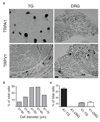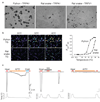Molecular basis of infrared detection by snakes
- PMID: 20228791
- PMCID: PMC2855400
- DOI: 10.1038/nature08943
Molecular basis of infrared detection by snakes
Abstract
Snakes possess a unique sensory system for detecting infrared radiation, enabling them to generate a 'thermal image' of predators or prey. Infrared signals are initially received by the pit organ, a highly specialized facial structure that is innervated by nerve fibres of the somatosensory system. How this organ detects and transduces infrared signals into nerve impulses is not known. Here we use an unbiased transcriptional profiling approach to identify TRPA1 channels as infrared receptors on sensory nerve fibres that innervate the pit organ. TRPA1 orthologues from pit-bearing snakes (vipers, pythons and boas) are the most heat-sensitive vertebrate ion channels thus far identified, consistent with their role as primary transducers of infrared stimuli. Thus, snakes detect infrared signals through a mechanism involving radiant heating of the pit organ, rather than photochemical transduction. These findings illustrate the broad evolutionary tuning of transient receptor potential (TRP) channels as thermosensors in the vertebrate nervous system.
Figures





References
-
- Bullock TH, Cowles RB. Physiology of an Infrared Receptor: The Facial Pit of Pit Vipers. Science. 1952;115:541–543. - PubMed
-
- Campbell AL, Naik RR, Sowards L, Stone MO. Biological infrared imaging and sensing. Micron. 2002;33:211–225. - PubMed
-
- Ebert J. Dr. rer. nat. thesis. Rheinische Friedrich Wilhelms University of Bonn; 2007. Infrared sense in snakes - behavioural and anatomical examinations (Crotalus atrox, Python regius, Corallus hortulanus)
-
- Barrett R, Maderson PFA, Meszler RM. In: Biology of Reptilia. Parsons TS, editor. Ch. 4. Academic Press; 1970. pp. 277–300.
-
- Ebert J, Schmitz A. In: Herpetologia Bonnensis II. Vences M, Kohler J, Ziegler T, Bohme W, editors. 2006. pp. 215–217.
Publication types
MeSH terms
Substances
Associated data
- Actions
- Actions
- Actions
- Actions
- Actions
- Actions
Grants and funding
LinkOut - more resources
Full Text Sources
Other Literature Sources
Medical
Molecular Biology Databases

